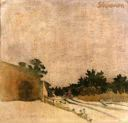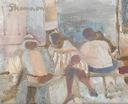Charles Shannon
American
(Montgomery, Alabama, 1914 - 1996, Montgomery, Alabama)
Many artists working in the South during the early part of the twentieth century depicted a world envisioned rather than experienced. Painters such as Anne Goldthwaite and Kelly Fitzpatrick deeply loved the South of their heritage, creating canvases that are the visual equivalents of love songs—romantic and willing to turn a blind eye to the beloved’s shortcomings. Charles Shannon was a generation younger and a pragmatist at heart. He loved the region equally well, but he loved it with eyes wide open, fully cognizant that for many of its citizens, life was not always sunny in the sunny South.
Shannon earned recognition for his artistic talent while he was still a very young man. He graduated from high school in Atlanta at fifteen and went to Emory University for two years. He entered the Cleveland School of Art in 1932, and after the first year he was on scholarship, graduating with honors in 1936. He later described what might have been his most important art-school experience: “The summer following my third year [1935], I got my first good portrait commission. With that and my uncle’s donation of a piece of land on his plantation [in Butler County], a dream born out of Cleveland winters was realized—a log cabin studio in the backwoods of Alabama…. I worked with the Negroes in building my cabin for two months—cutting down trees, taking them with mules to the site of the cabin, building it. I went to their churches with them, to their dances and drank with them…. I came to love this land, the plants and the people that grew from it." (1)
Shannon returned to the Cleveland School of Art, where outside of class he painted the subjects from black rural life he had discovered that previous summer. In 1938 he exhibited this and similar works at the Cleveland School of Art Gallery, and, as a result of that exhibition, in April 1938 he won a Julius Rosenwald Fellowship that that was renewed the folllowing year. In May of that year, his work was exhibited at the Jacques Seligman & Company gallery in New York. The following year, Shannon joined a group of like-minded artists in forming the New South art center in Montgomery. (2) Located in commercial space on a major downtown thoroughfare, the enterprise functioned for about a year. Before it closed, however, New South hosted the first exhibition of the work of self-taught artist Bill Traylor, whom Shannon had noticed working on a city street. Shannon served as an artist-corespondent in World War II and then returned to Montgomery, where he taught at Auburn University at Montgomery (AUM) until his retirement in 1979.
(1) Charles Shannon, quoted in Charles Shannon: Paintings of the South (New York: Jacques Seligmann and Company, 1938), n.p
(2) For an extended account of the New South experiment, see Miriam Fowler, New South, New Deal, and Beyond (Montgomery: The Alabama State Council on the Arts, 1989).
American Paintings from the Montgomery Museum of Fine Arts, cat. no. 91, p. 214.
American
(Montgomery, Alabama, 1914 - 1996, Montgomery, Alabama)
Many artists working in the South during the early part of the twentieth century depicted a world envisioned rather than experienced. Painters such as Anne Goldthwaite and Kelly Fitzpatrick deeply loved the South of their heritage, creating canvases that are the visual equivalents of love songs—romantic and willing to turn a blind eye to the beloved’s shortcomings. Charles Shannon was a generation younger and a pragmatist at heart. He loved the region equally well, but he loved it with eyes wide open, fully cognizant that for many of its citizens, life was not always sunny in the sunny South.
Shannon earned recognition for his artistic talent while he was still a very young man. He graduated from high school in Atlanta at fifteen and went to Emory University for two years. He entered the Cleveland School of Art in 1932, and after the first year he was on scholarship, graduating with honors in 1936. He later described what might have been his most important art-school experience: “The summer following my third year [1935], I got my first good portrait commission. With that and my uncle’s donation of a piece of land on his plantation [in Butler County], a dream born out of Cleveland winters was realized—a log cabin studio in the backwoods of Alabama…. I worked with the Negroes in building my cabin for two months—cutting down trees, taking them with mules to the site of the cabin, building it. I went to their churches with them, to their dances and drank with them…. I came to love this land, the plants and the people that grew from it." (1)
Shannon returned to the Cleveland School of Art, where outside of class he painted the subjects from black rural life he had discovered that previous summer. In 1938 he exhibited this and similar works at the Cleveland School of Art Gallery, and, as a result of that exhibition, in April 1938 he won a Julius Rosenwald Fellowship that that was renewed the folllowing year. In May of that year, his work was exhibited at the Jacques Seligman & Company gallery in New York. The following year, Shannon joined a group of like-minded artists in forming the New South art center in Montgomery. (2) Located in commercial space on a major downtown thoroughfare, the enterprise functioned for about a year. Before it closed, however, New South hosted the first exhibition of the work of self-taught artist Bill Traylor, whom Shannon had noticed working on a city street. Shannon served as an artist-corespondent in World War II and then returned to Montgomery, where he taught at Auburn University at Montgomery (AUM) until his retirement in 1979.
(1) Charles Shannon, quoted in Charles Shannon: Paintings of the South (New York: Jacques Seligmann and Company, 1938), n.p
(2) For an extended account of the New South experiment, see Miriam Fowler, New South, New Deal, and Beyond (Montgomery: The Alabama State Council on the Arts, 1989).
American Paintings from the Montgomery Museum of Fine Arts, cat. no. 91, p. 214.



